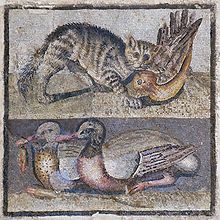- Opus vermiculatum
-
 Central emblema of a floor mosaic with a cat and two ducks, first quarter of the 1st century BC, Palazzo Massimo alle Terme
Central emblema of a floor mosaic with a cat and two ducks, first quarter of the 1st century BC, Palazzo Massimo alle Terme
Opus vermiculatum is a type of mosaic which draws an outline around shapes using tesserae. This can be one or more rows and then contrasted in the background, typically with Opus tessellatum. The outline created is often light and offset by a dark background for greater contrast. The name opus vermiculatum literally means "worm-like work", and has been described as the being one of the most demanding and elaborate forms of Roman mosaic.[1] Usually opus vermiculatum is meant to put emphasis on the main design and foreground details of a work, using a smooth and flowing halo-effect. Sometimes it was used only around the head of a figure. The tesserae used were often square but can be variously shaped.[2]
History
Opus vermiculatum originated in Greece, later than other mosaic types. The first example is the Sophilos mosaic of Thmuis, which has been dated to around 200 BC. It spread throughout the Hellenistic world, including to Egypt, which used it for tomb decoration from the late 3rd to 1st century BC, and Syria, where it survived into later times. The Nile Mosaic has a very refined use of color and shows an advanced development. This may indicate that the technique was based on paintings.[3] In the 1st century BC, it reached Italy along with other mosaic types. In Rome this type was common in the houses of Delos.[2] Many fine example of this style have been found at Pompei. One remarkable work in particular portrays a scene of the Battle of Issus, which was probably copied from a 4th century BC painting. The use of opus vermiculatum declined after the 1st century AD, but continued to be used the major style employed for finer Roman mosaics until the 4th century. By then, mosaics were becoming increasingly impressionistic, taking advantage of the crystalline reflection of the tesserae, which was better suited to opus tessellatum. It was eventually entirely abandoned for this style.[4]
Notes
- ^ Berman, Alan (2000). Floors. frances lincoln ltd. ISBN 0-7112-1612-6. p. 72.
- ^ a b Strong, Donald (June 1, 1992). Roman Art: The Yale University Press Pelican History of Art. Yale University Press. ISBN 0-300-05293-6. p. 56
- ^ Meyboom, P G P (January 1, 1994). The Nile Mosaic of Palestrina: Early Evidence of Egyptian Religion in Italy. Brill Academic Publishers. ISBN 90-04-10137-3. p. 379.
- ^ "opus vermiculatum." Encyclopædia Britannica. 2006.
Categories:
Wikimedia Foundation. 2010.
